AI in BI: Exploring the Value of AI-Powered Business Intelligence
VerifiedAdded on 2022/01/03
|25
|6980
|131
Report
AI Summary
This report, "The Value of AI-Powered Business Intelligence," explores the transformative impact of artificial intelligence (AI) on business intelligence (BI). It defines AI and BI, highlighting how AI enhances data analysis, visualization, and communication, and automates data preparation. The report discusses why AI is becoming ubiquitous, including advancements in computing power, data accessibility, and machine learning. It explains how AI improves BI by empowering line-of-business users, utilizing natural language interfaces, and automating data processes. The report also covers AI adoption strategies and forecasts the future of AI in BI, emphasizing its potential to revolutionize how businesses operate by providing actionable insights and improving decision-making processes. The report also touches on the role of machine learning and deep learning in AI systems.
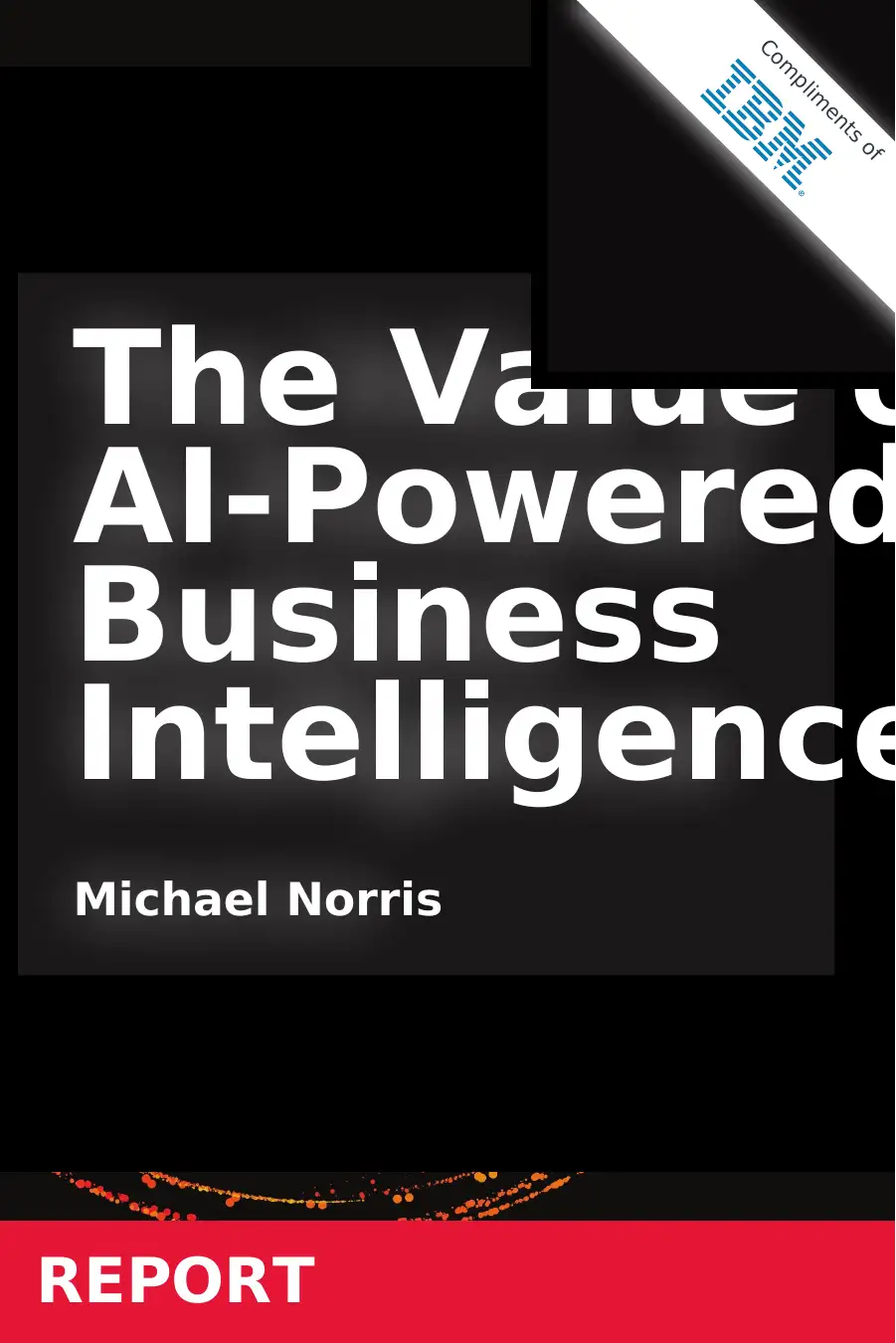
REPORT
The Value o
AI-Powered
Business
Intelligence
Michael Norris
Compliments of
The Value o
AI-Powered
Business
Intelligence
Michael Norris
Compliments of
Paraphrase This Document
Need a fresh take? Get an instant paraphrase of this document with our AI Paraphraser

Michael Norris
The Value of AI-Powe
Business Intelligen
BostonFarnhamSebastopolTokyoBeijingBostonFarnhamSebastopolTokyoBeijing
The Value of AI-Powe
Business Intelligen
BostonFarnhamSebastopolTokyoBeijingBostonFarnhamSebastopolTokyoBeijing
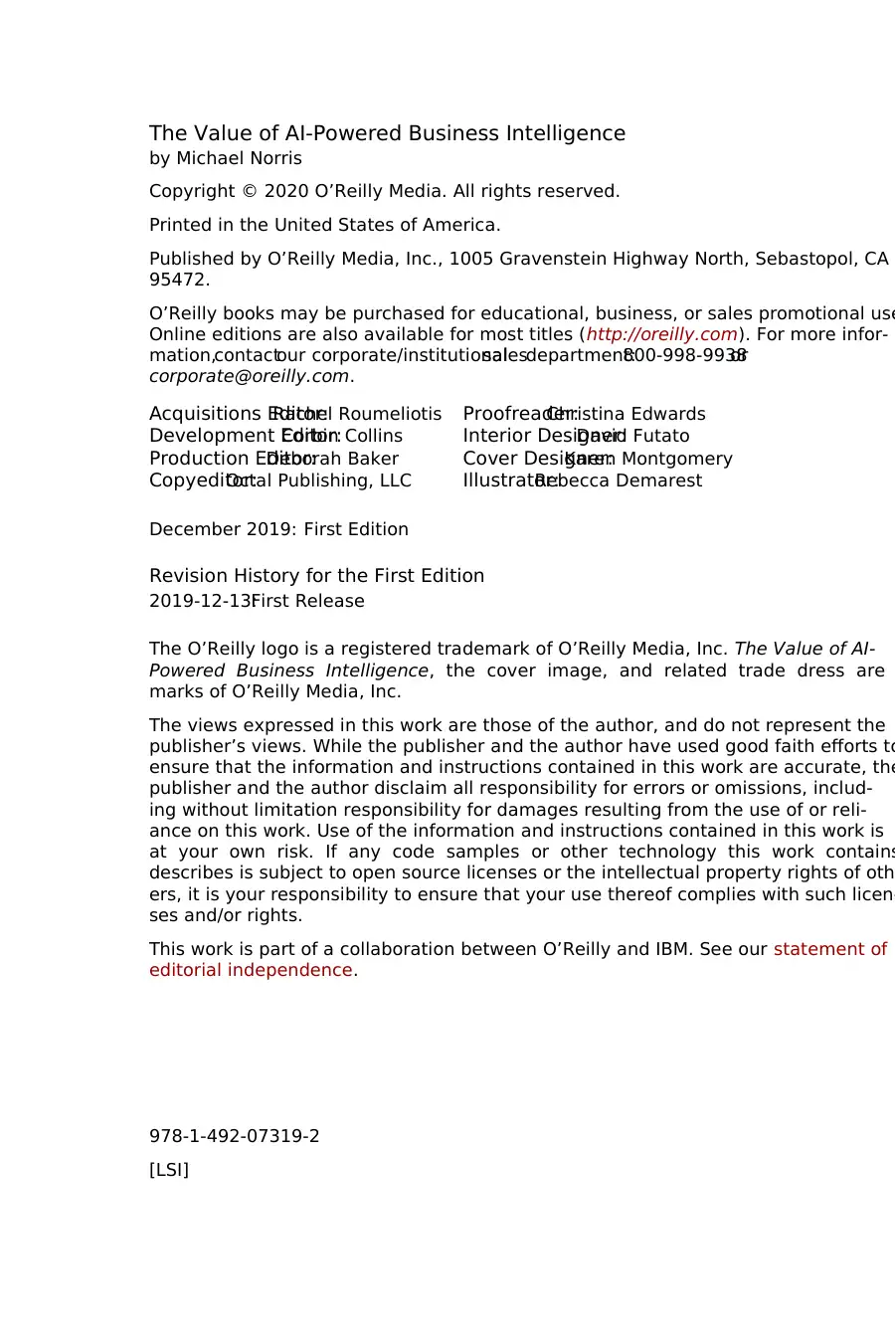
978-1-492-07319-2
[LSI]
The Value of AI-Powered Business Intelligence
by Michael Norris
Copyright © 2020 O’Reilly Media. All rights reserved.
Printed in the United States of America.
Published by O’Reilly Media, Inc., 1005 Gravenstein Highway North, Sebastopol, CA
95472.
O’Reilly books may be purchased for educational, business, or sales promotional use
Online editions are also available for most titles (http://oreilly.com). For more infor‐
mation,contactour corporate/institutionalsalesdepartment:800-998-9938or
corporate@oreilly.com.
Acquisitions Editor:Rachel Roumeliotis
Development Editor:Corbin Collins
Production Editor:Deborah Baker
Copyeditor:Octal Publishing, LLC
Proofreader:Christina Edwards
Interior Designer:David Futato
Cover Designer:Karen Montgomery
Illustrator:Rebecca Demarest
December 2019: First Edition
Revision History for the First Edition
2019-12-13:First Release
The O’Reilly logo is a registered trademark of O’Reilly Media, Inc. The Value of AI-
Powered Business Intelligence, the cover image, and related trade dress are
marks of O’Reilly Media, Inc.
The views expressed in this work are those of the author, and do not represent the
publisher’s views. While the publisher and the author have used good faith efforts to
ensure that the information and instructions contained in this work are accurate, the
publisher and the author disclaim all responsibility for errors or omissions, includ‐
ing without limitation responsibility for damages resulting from the use of or reli‐
ance on this work. Use of the information and instructions contained in this work is
at your own risk. If any code samples or other technology this work contains
describes is subject to open source licenses or the intellectual property rights of oth
ers, it is your responsibility to ensure that your use thereof complies with such licen‐
ses and/or rights.
This work is part of a collaboration between O’Reilly and IBM. See our statement of
editorial independence.
[LSI]
The Value of AI-Powered Business Intelligence
by Michael Norris
Copyright © 2020 O’Reilly Media. All rights reserved.
Printed in the United States of America.
Published by O’Reilly Media, Inc., 1005 Gravenstein Highway North, Sebastopol, CA
95472.
O’Reilly books may be purchased for educational, business, or sales promotional use
Online editions are also available for most titles (http://oreilly.com). For more infor‐
mation,contactour corporate/institutionalsalesdepartment:800-998-9938or
corporate@oreilly.com.
Acquisitions Editor:Rachel Roumeliotis
Development Editor:Corbin Collins
Production Editor:Deborah Baker
Copyeditor:Octal Publishing, LLC
Proofreader:Christina Edwards
Interior Designer:David Futato
Cover Designer:Karen Montgomery
Illustrator:Rebecca Demarest
December 2019: First Edition
Revision History for the First Edition
2019-12-13:First Release
The O’Reilly logo is a registered trademark of O’Reilly Media, Inc. The Value of AI-
Powered Business Intelligence, the cover image, and related trade dress are
marks of O’Reilly Media, Inc.
The views expressed in this work are those of the author, and do not represent the
publisher’s views. While the publisher and the author have used good faith efforts to
ensure that the information and instructions contained in this work are accurate, the
publisher and the author disclaim all responsibility for errors or omissions, includ‐
ing without limitation responsibility for damages resulting from the use of or reli‐
ance on this work. Use of the information and instructions contained in this work is
at your own risk. If any code samples or other technology this work contains
describes is subject to open source licenses or the intellectual property rights of oth
ers, it is your responsibility to ensure that your use thereof complies with such licen‐
ses and/or rights.
This work is part of a collaboration between O’Reilly and IBM. See our statement of
editorial independence.
⊘ This is a preview!⊘
Do you want full access?
Subscribe today to unlock all pages.

Trusted by 1+ million students worldwide
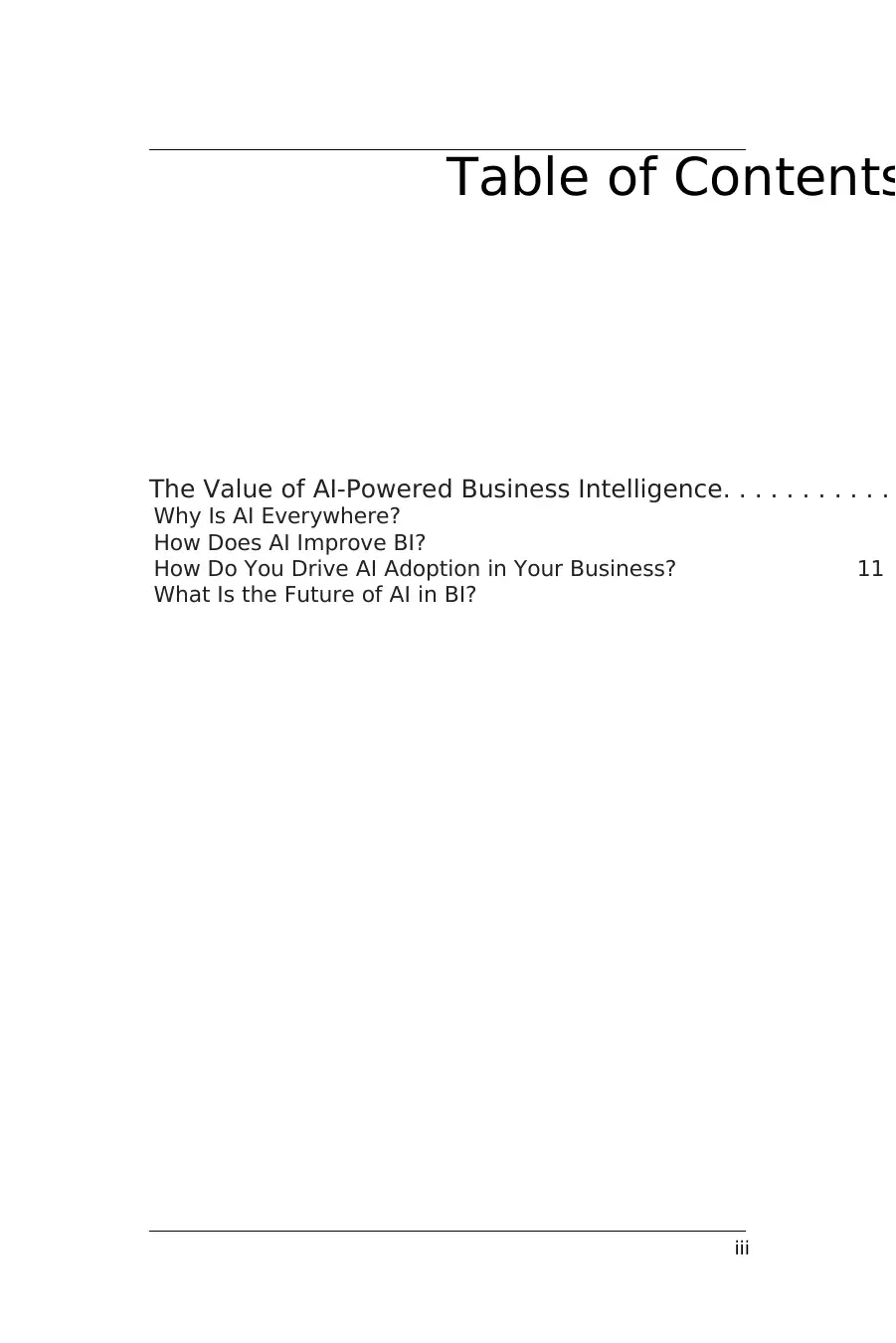
Table of Contents
The Value of AI-Powered Business Intelligence. . . . . . . . . . .
Why Is AI Everywhere?
How Does AI Improve BI?
How Do You Drive AI Adoption in Your Business? 11
What Is the Future of AI in BI?
iii
The Value of AI-Powered Business Intelligence. . . . . . . . . . .
Why Is AI Everywhere?
How Does AI Improve BI?
How Do You Drive AI Adoption in Your Business? 11
What Is the Future of AI in BI?
iii
Paraphrase This Document
Need a fresh take? Get an instant paraphrase of this document with our AI Paraphraser

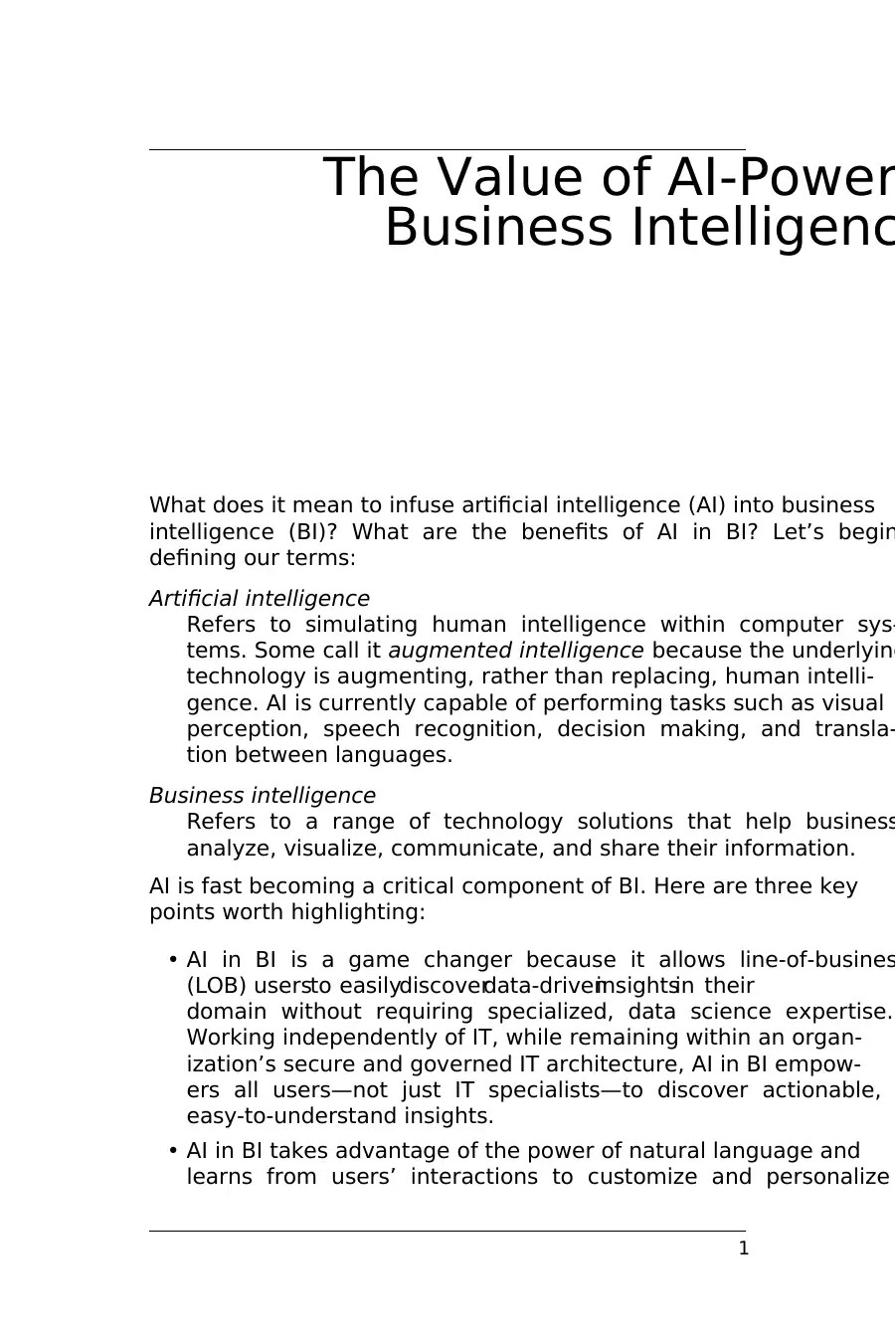
The Value of AI-Power
Business Intelligenc
What does it mean to infuse artificial intelligence (AI) into business
intelligence (BI)? What are the benefits of AI in BI? Let’s begin
defining our terms:
Artificial intelligence
Refers to simulating human intelligence within computer sys‐
tems. Some call it augmented intelligence because the underlying
technology is augmenting, rather than replacing, human intelli‐
gence. AI is currently capable of performing tasks such as visual
perception, speech recognition, decision making, and transla‐
tion between languages.
Business intelligence
Refers to a range of technology solutions that help business
analyze, visualize, communicate, and share their information.
AI is fast becoming a critical component of BI. Here are three key
points worth highlighting:
• AI in BI is a game changer because it allows line-of-busines
(LOB) usersto easilydiscoverdata-driveninsightsin their
domain without requiring specialized, data science expertise.
Working independently of IT, while remaining within an organ‐
ization’s secure and governed IT architecture, AI in BI empow‐
ers all users—not just IT specialists—to discover actionable,
easy-to-understand insights.
• AI in BI takes advantage of the power of natural language and
learns from users’ interactions to customize and personalize
1
Business Intelligenc
What does it mean to infuse artificial intelligence (AI) into business
intelligence (BI)? What are the benefits of AI in BI? Let’s begin
defining our terms:
Artificial intelligence
Refers to simulating human intelligence within computer sys‐
tems. Some call it augmented intelligence because the underlying
technology is augmenting, rather than replacing, human intelli‐
gence. AI is currently capable of performing tasks such as visual
perception, speech recognition, decision making, and transla‐
tion between languages.
Business intelligence
Refers to a range of technology solutions that help business
analyze, visualize, communicate, and share their information.
AI is fast becoming a critical component of BI. Here are three key
points worth highlighting:
• AI in BI is a game changer because it allows line-of-busines
(LOB) usersto easilydiscoverdata-driveninsightsin their
domain without requiring specialized, data science expertise.
Working independently of IT, while remaining within an organ‐
ization’s secure and governed IT architecture, AI in BI empow‐
ers all users—not just IT specialists—to discover actionable,
easy-to-understand insights.
• AI in BI takes advantage of the power of natural language and
learns from users’ interactions to customize and personalize
1
⊘ This is a preview!⊘
Do you want full access?
Subscribe today to unlock all pages.

Trusted by 1+ million students worldwide
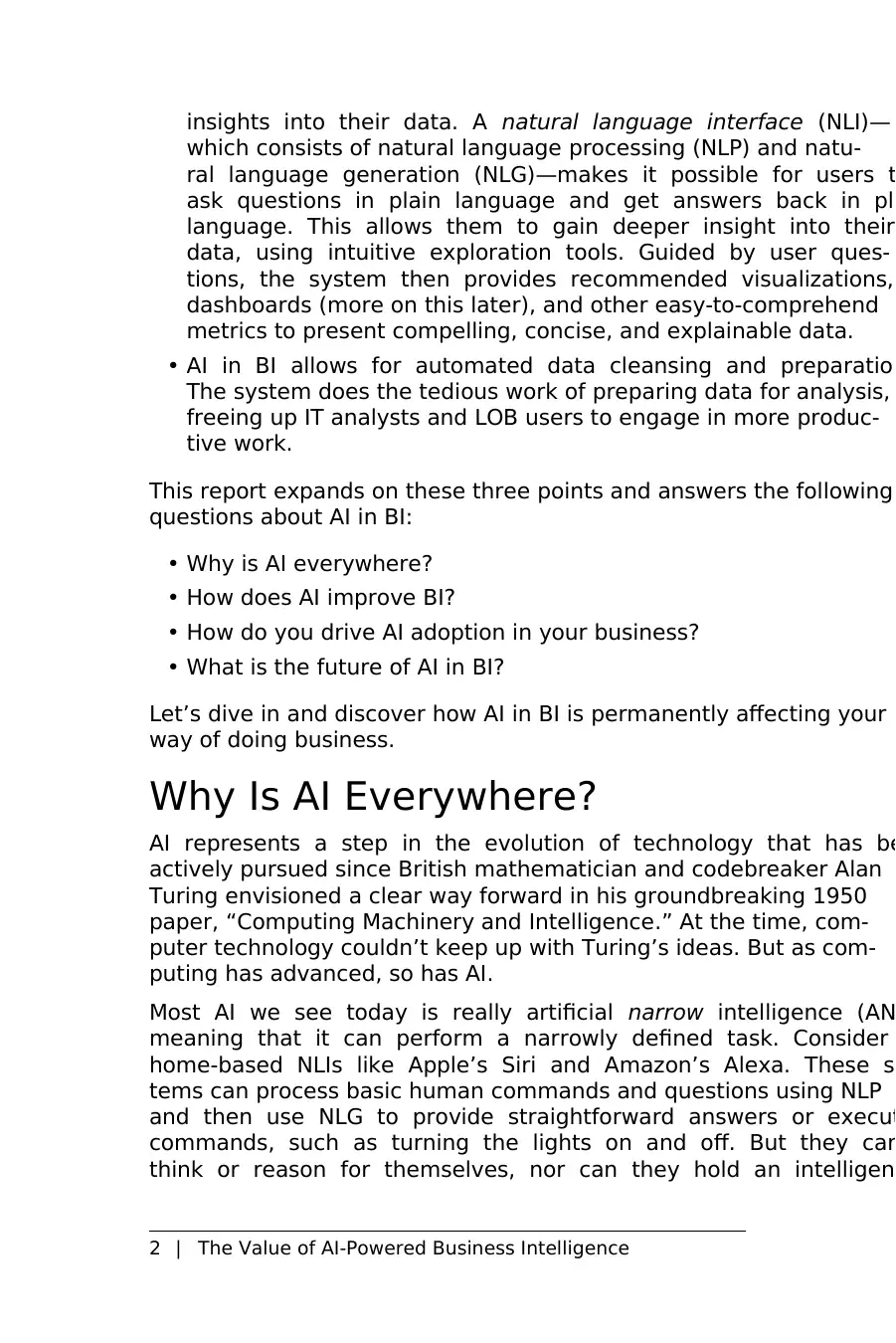
insights into their data. A natural language interface (NLI)—
which consists of natural language processing (NLP) and natu‐
ral language generation (NLG)—makes it possible for users t
ask questions in plain language and get answers back in pla
language. This allows them to gain deeper insight into their
data, using intuitive exploration tools. Guided by user ques‐
tions, the system then provides recommended visualizations,
dashboards (more on this later), and other easy-to-comprehend
metrics to present compelling, concise, and explainable data.
• AI in BI allows for automated data cleansing and preparation
The system does the tedious work of preparing data for analysis,
freeing up IT analysts and LOB users to engage in more produc‐
tive work.
This report expands on these three points and answers the following
questions about AI in BI:
• Why is AI everywhere?
• How does AI improve BI?
• How do you drive AI adoption in your business?
• What is the future of AI in BI?
Let’s dive in and discover how AI in BI is permanently affecting your
way of doing business.
Why Is AI Everywhere?
AI represents a step in the evolution of technology that has be
actively pursued since British mathematician and codebreaker Alan
Turing envisioned a clear way forward in his groundbreaking 1950
paper, “Computing Machinery and Intelligence.” At the time, com‐
puter technology couldn’t keep up with Turing’s ideas. But as com‐
puting has advanced, so has AI.
Most AI we see today is really artificial narrow intelligence (AN
meaning that it can perform a narrowly defined task. Consider
home-based NLIs like Apple’s Siri and Amazon’s Alexa. These sy
tems can process basic human commands and questions using NLP
and then use NLG to provide straightforward answers or execut
commands, such as turning the lights on and off. But they can
think or reason for themselves, nor can they hold an intelligent
2 | The Value of AI-Powered Business Intelligence
which consists of natural language processing (NLP) and natu‐
ral language generation (NLG)—makes it possible for users t
ask questions in plain language and get answers back in pla
language. This allows them to gain deeper insight into their
data, using intuitive exploration tools. Guided by user ques‐
tions, the system then provides recommended visualizations,
dashboards (more on this later), and other easy-to-comprehend
metrics to present compelling, concise, and explainable data.
• AI in BI allows for automated data cleansing and preparation
The system does the tedious work of preparing data for analysis,
freeing up IT analysts and LOB users to engage in more produc‐
tive work.
This report expands on these three points and answers the following
questions about AI in BI:
• Why is AI everywhere?
• How does AI improve BI?
• How do you drive AI adoption in your business?
• What is the future of AI in BI?
Let’s dive in and discover how AI in BI is permanently affecting your
way of doing business.
Why Is AI Everywhere?
AI represents a step in the evolution of technology that has be
actively pursued since British mathematician and codebreaker Alan
Turing envisioned a clear way forward in his groundbreaking 1950
paper, “Computing Machinery and Intelligence.” At the time, com‐
puter technology couldn’t keep up with Turing’s ideas. But as com‐
puting has advanced, so has AI.
Most AI we see today is really artificial narrow intelligence (AN
meaning that it can perform a narrowly defined task. Consider
home-based NLIs like Apple’s Siri and Amazon’s Alexa. These sy
tems can process basic human commands and questions using NLP
and then use NLG to provide straightforward answers or execut
commands, such as turning the lights on and off. But they can
think or reason for themselves, nor can they hold an intelligent
2 | The Value of AI-Powered Business Intelligence
Paraphrase This Document
Need a fresh take? Get an instant paraphrase of this document with our AI Paraphraser
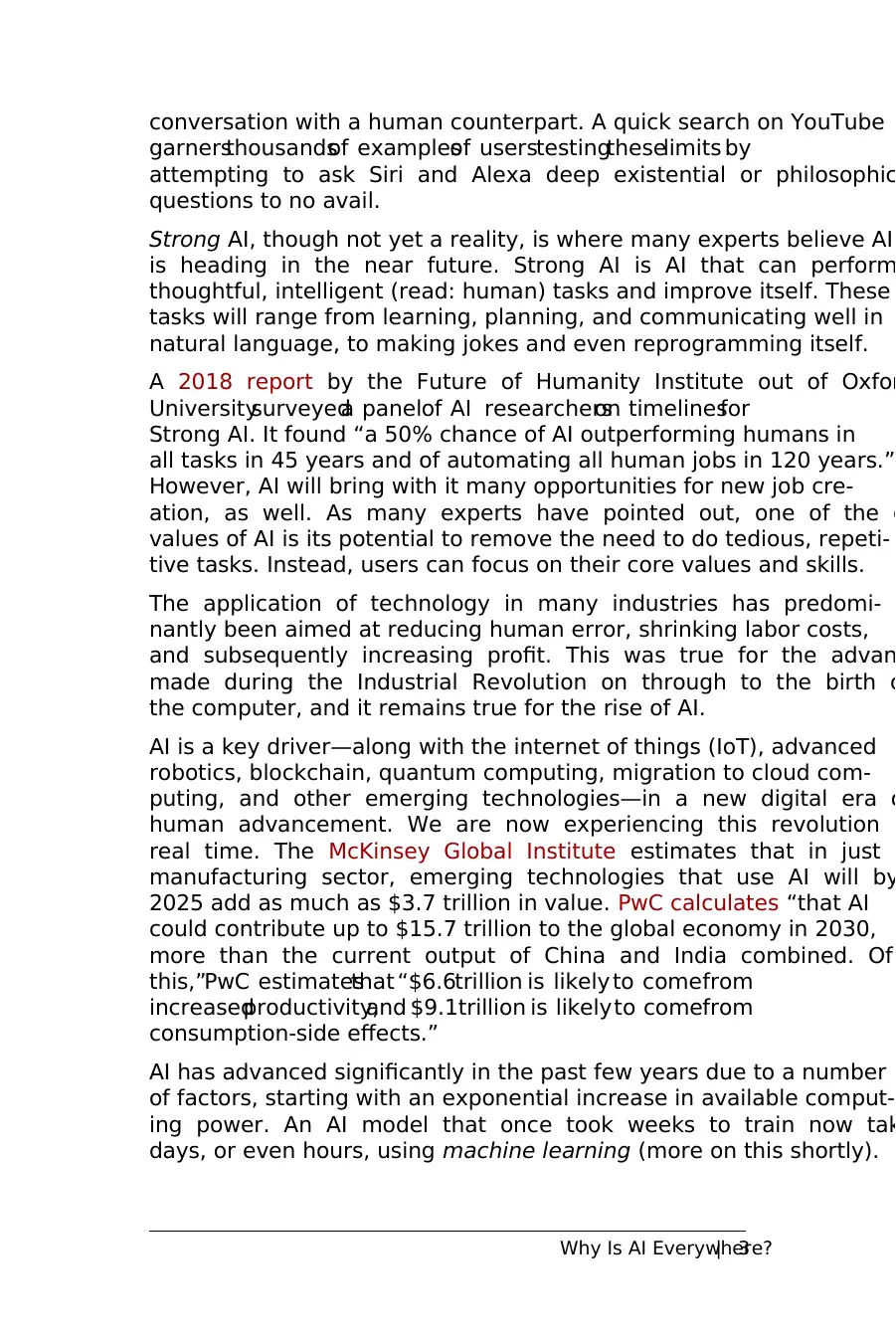
conversation with a human counterpart. A quick search on YouTube
garnersthousandsof examplesof userstestingtheselimits by
attempting to ask Siri and Alexa deep existential or philosophic
questions to no avail.
Strong AI, though not yet a reality, is where many experts believe AI
is heading in the near future. Strong AI is AI that can perform
thoughtful, intelligent (read: human) tasks and improve itself. These
tasks will range from learning, planning, and communicating well in
natural language, to making jokes and even reprogramming itself.
A 2018 report by the Future of Humanity Institute out of Oxfor
Universitysurveyeda panelof AI researcherson timelinesfor
Strong AI. It found “a 50% chance of AI outperforming humans in
all tasks in 45 years and of automating all human jobs in 120 years.”
However, AI will bring with it many opportunities for new job cre‐
ation, as well. As many experts have pointed out, one of the g
values of AI is its potential to remove the need to do tedious, repeti‐
tive tasks. Instead, users can focus on their core values and skills.
The application of technology in many industries has predomi‐
nantly been aimed at reducing human error, shrinking labor costs,
and subsequently increasing profit. This was true for the advan
made during the Industrial Revolution on through to the birth o
the computer, and it remains true for the rise of AI.
AI is a key driver—along with the internet of things (IoT), advanced
robotics, blockchain, quantum computing, migration to cloud com‐
puting, and other emerging technologies—in a new digital era o
human advancement. We are now experiencing this revolution i
real time. The McKinsey Global Institute estimates that in just t
manufacturing sector, emerging technologies that use AI will by
2025 add as much as $3.7 trillion in value. PwC calculates “that AI
could contribute up to $15.7 trillion to the global economy in 2030,
more than the current output of China and India combined. Of
this,”PwC estimatesthat “$6.6trillion is likely to comefrom
increasedproductivity,and $9.1trillion is likely to comefrom
consumption-side effects.”
AI has advanced significantly in the past few years due to a number
of factors, starting with an exponential increase in available comput‐
ing power. An AI model that once took weeks to train now tak
days, or even hours, using machine learning (more on this shortly).
Why Is AI Everywhere?| 3
garnersthousandsof examplesof userstestingtheselimits by
attempting to ask Siri and Alexa deep existential or philosophic
questions to no avail.
Strong AI, though not yet a reality, is where many experts believe AI
is heading in the near future. Strong AI is AI that can perform
thoughtful, intelligent (read: human) tasks and improve itself. These
tasks will range from learning, planning, and communicating well in
natural language, to making jokes and even reprogramming itself.
A 2018 report by the Future of Humanity Institute out of Oxfor
Universitysurveyeda panelof AI researcherson timelinesfor
Strong AI. It found “a 50% chance of AI outperforming humans in
all tasks in 45 years and of automating all human jobs in 120 years.”
However, AI will bring with it many opportunities for new job cre‐
ation, as well. As many experts have pointed out, one of the g
values of AI is its potential to remove the need to do tedious, repeti‐
tive tasks. Instead, users can focus on their core values and skills.
The application of technology in many industries has predomi‐
nantly been aimed at reducing human error, shrinking labor costs,
and subsequently increasing profit. This was true for the advan
made during the Industrial Revolution on through to the birth o
the computer, and it remains true for the rise of AI.
AI is a key driver—along with the internet of things (IoT), advanced
robotics, blockchain, quantum computing, migration to cloud com‐
puting, and other emerging technologies—in a new digital era o
human advancement. We are now experiencing this revolution i
real time. The McKinsey Global Institute estimates that in just t
manufacturing sector, emerging technologies that use AI will by
2025 add as much as $3.7 trillion in value. PwC calculates “that AI
could contribute up to $15.7 trillion to the global economy in 2030,
more than the current output of China and India combined. Of
this,”PwC estimatesthat “$6.6trillion is likely to comefrom
increasedproductivity,and $9.1trillion is likely to comefrom
consumption-side effects.”
AI has advanced significantly in the past few years due to a number
of factors, starting with an exponential increase in available comput‐
ing power. An AI model that once took weeks to train now tak
days, or even hours, using machine learning (more on this shortly).
Why Is AI Everywhere?| 3
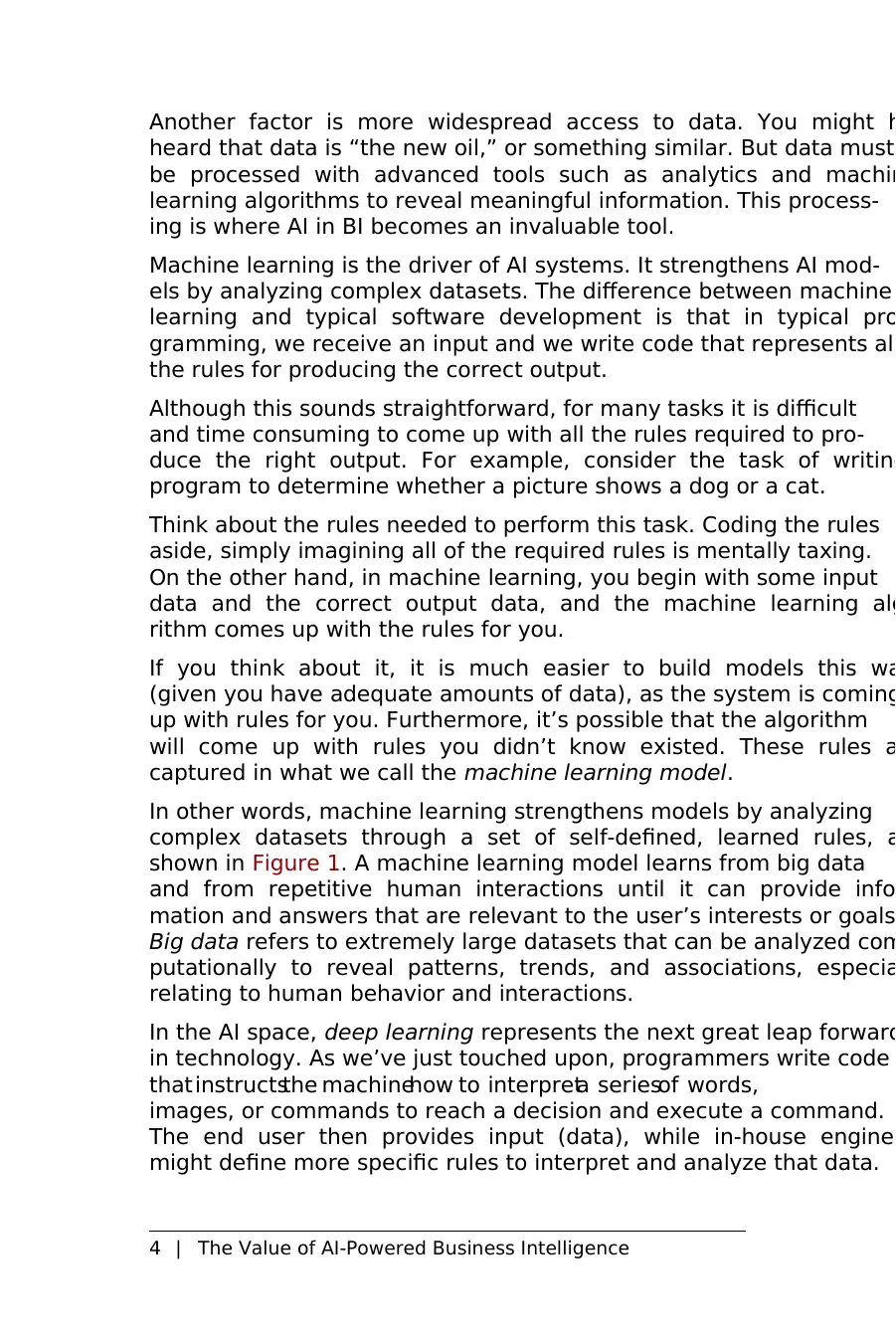
Another factor is more widespread access to data. You might h
heard that data is “the new oil,” or something similar. But data must
be processed with advanced tools such as analytics and machin
learning algorithms to reveal meaningful information. This process‐
ing is where AI in BI becomes an invaluable tool.
Machine learning is the driver of AI systems. It strengthens AI mod‐
els by analyzing complex datasets. The difference between machine
learning and typical software development is that in typical pro
gramming, we receive an input and we write code that represents all
the rules for producing the correct output.
Although this sounds straightforward, for many tasks it is difficult
and time consuming to come up with all the rules required to pro‐
duce the right output. For example, consider the task of writing
program to determine whether a picture shows a dog or a cat.
Think about the rules needed to perform this task. Coding the rules
aside, simply imagining all of the required rules is mentally taxing.
On the other hand, in machine learning, you begin with some input
data and the correct output data, and the machine learning alg
rithm comes up with the rules for you.
If you think about it, it is much easier to build models this wa
(given you have adequate amounts of data), as the system is coming
up with rules for you. Furthermore, it’s possible that the algorithm
will come up with rules you didn’t know existed. These rules a
captured in what we call the machine learning model.
In other words, machine learning strengthens models by analyzing
complex datasets through a set of self-defined, learned rules, a
shown in Figure 1. A machine learning model learns from big data
and from repetitive human interactions until it can provide info
mation and answers that are relevant to the user’s interests or goals
Big data refers to extremely large datasets that can be analyzed com
putationally to reveal patterns, trends, and associations, especia
relating to human behavior and interactions.
In the AI space, deep learning represents the next great leap forward
in technology. As we’ve just touched upon, programmers write code
that instructsthe machinehow to interpreta seriesof words,
images, or commands to reach a decision and execute a command.
The end user then provides input (data), while in-house enginee
might define more specific rules to interpret and analyze that data.
4 | The Value of AI-Powered Business Intelligence
heard that data is “the new oil,” or something similar. But data must
be processed with advanced tools such as analytics and machin
learning algorithms to reveal meaningful information. This process‐
ing is where AI in BI becomes an invaluable tool.
Machine learning is the driver of AI systems. It strengthens AI mod‐
els by analyzing complex datasets. The difference between machine
learning and typical software development is that in typical pro
gramming, we receive an input and we write code that represents all
the rules for producing the correct output.
Although this sounds straightforward, for many tasks it is difficult
and time consuming to come up with all the rules required to pro‐
duce the right output. For example, consider the task of writing
program to determine whether a picture shows a dog or a cat.
Think about the rules needed to perform this task. Coding the rules
aside, simply imagining all of the required rules is mentally taxing.
On the other hand, in machine learning, you begin with some input
data and the correct output data, and the machine learning alg
rithm comes up with the rules for you.
If you think about it, it is much easier to build models this wa
(given you have adequate amounts of data), as the system is coming
up with rules for you. Furthermore, it’s possible that the algorithm
will come up with rules you didn’t know existed. These rules a
captured in what we call the machine learning model.
In other words, machine learning strengthens models by analyzing
complex datasets through a set of self-defined, learned rules, a
shown in Figure 1. A machine learning model learns from big data
and from repetitive human interactions until it can provide info
mation and answers that are relevant to the user’s interests or goals
Big data refers to extremely large datasets that can be analyzed com
putationally to reveal patterns, trends, and associations, especia
relating to human behavior and interactions.
In the AI space, deep learning represents the next great leap forward
in technology. As we’ve just touched upon, programmers write code
that instructsthe machinehow to interpreta seriesof words,
images, or commands to reach a decision and execute a command.
The end user then provides input (data), while in-house enginee
might define more specific rules to interpret and analyze that data.
4 | The Value of AI-Powered Business Intelligence
⊘ This is a preview!⊘
Do you want full access?
Subscribe today to unlock all pages.

Trusted by 1+ million students worldwide
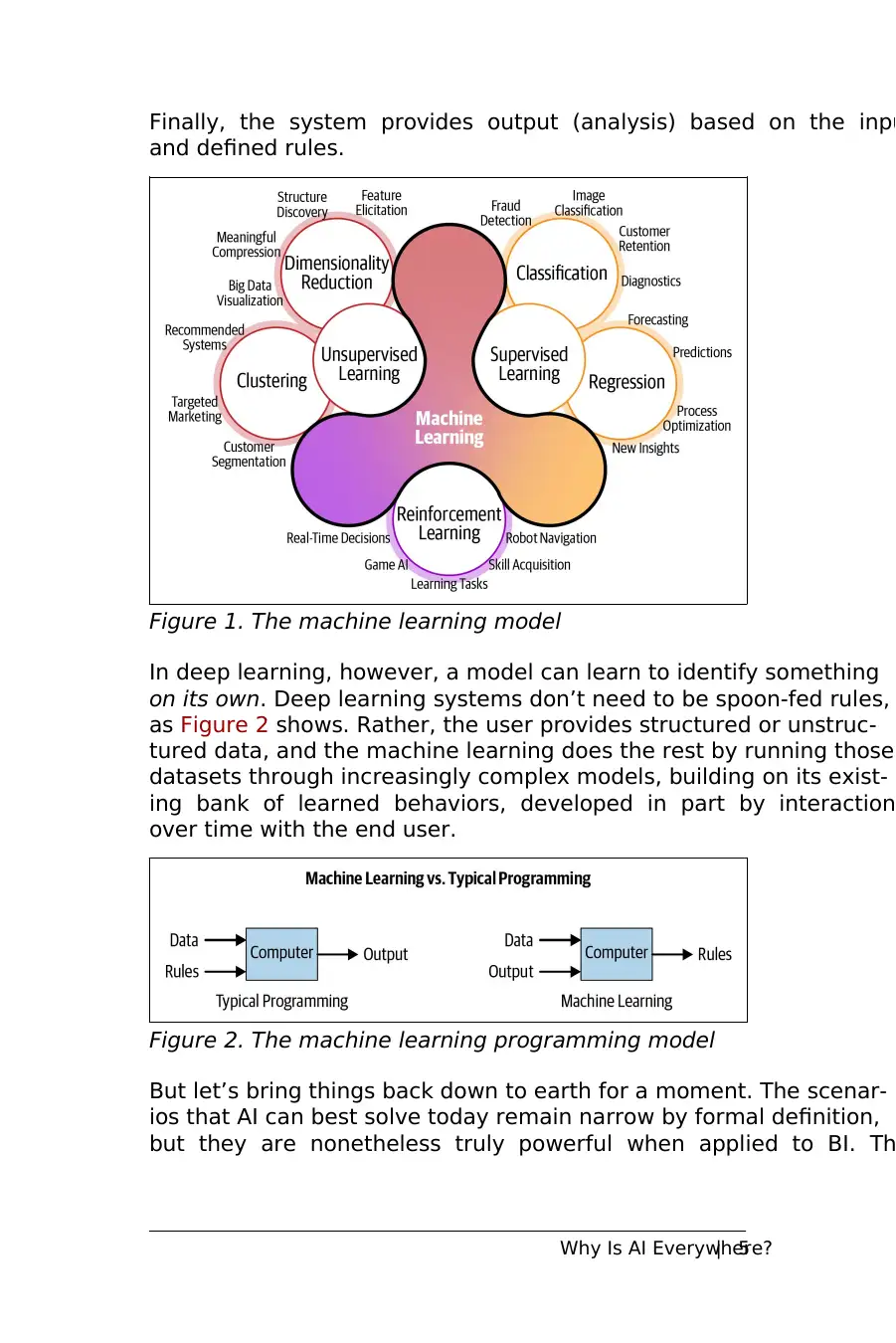
Finally, the system provides output (analysis) based on the inpu
and defined rules.
Figure 1. The machine learning model
In deep learning, however, a model can learn to identify something
on its own. Deep learning systems don’t need to be spoon-fed rules,
as Figure 2 shows. Rather, the user provides structured or unstruc‐
tured data, and the machine learning does the rest by running those
datasets through increasingly complex models, building on its exist‐
ing bank of learned behaviors, developed in part by interaction
over time with the end user.
Figure 2. The machine learning programming model
But let’s bring things back down to earth for a moment. The scenar‐
ios that AI can best solve today remain narrow by formal definition,
but they are nonetheless truly powerful when applied to BI. Th
Why Is AI Everywhere?| 5
and defined rules.
Figure 1. The machine learning model
In deep learning, however, a model can learn to identify something
on its own. Deep learning systems don’t need to be spoon-fed rules,
as Figure 2 shows. Rather, the user provides structured or unstruc‐
tured data, and the machine learning does the rest by running those
datasets through increasingly complex models, building on its exist‐
ing bank of learned behaviors, developed in part by interaction
over time with the end user.
Figure 2. The machine learning programming model
But let’s bring things back down to earth for a moment. The scenar‐
ios that AI can best solve today remain narrow by formal definition,
but they are nonetheless truly powerful when applied to BI. Th
Why Is AI Everywhere?| 5
Paraphrase This Document
Need a fresh take? Get an instant paraphrase of this document with our AI Paraphraser
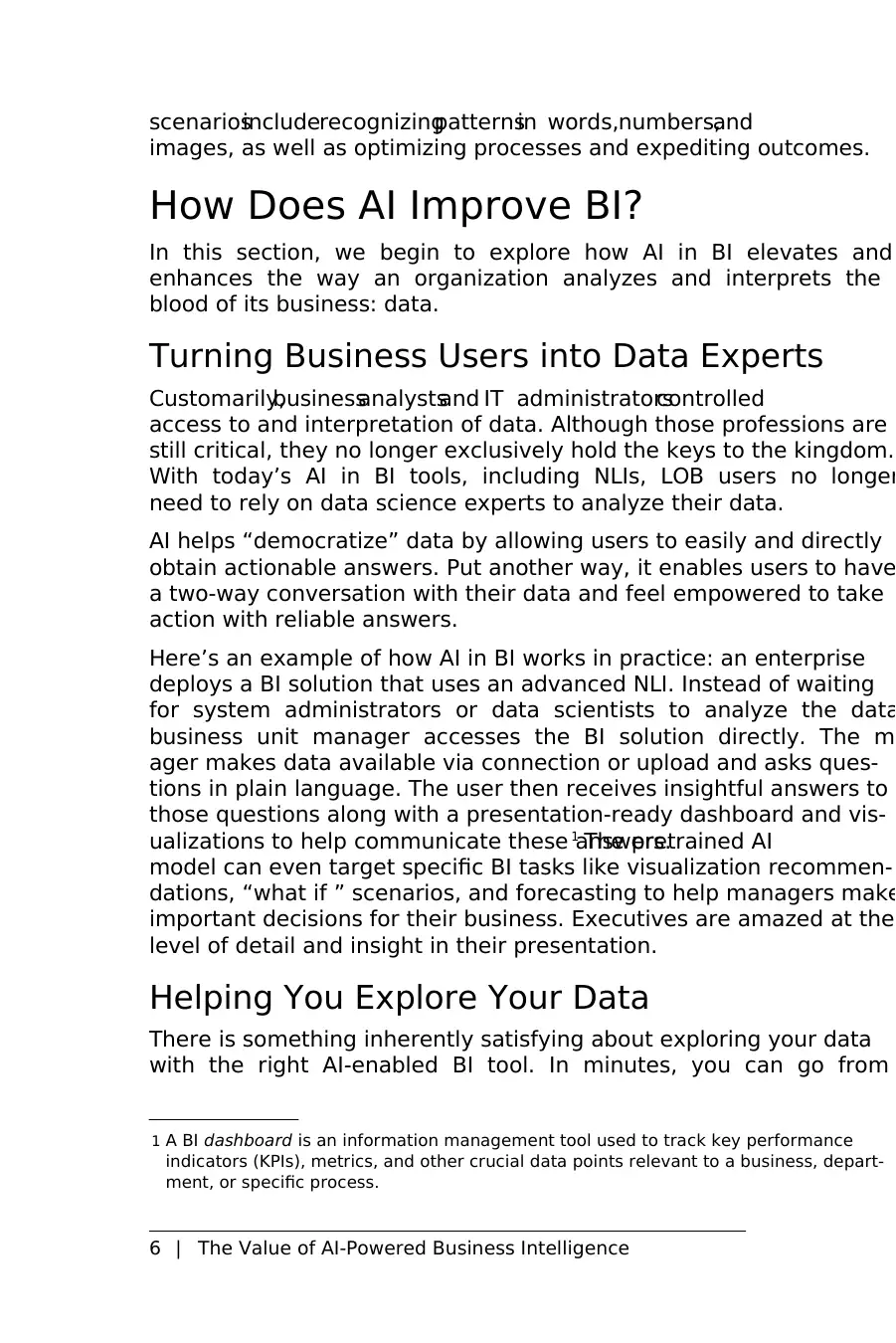
1 A BI dashboard is an information management tool used to track key performance
indicators (KPIs), metrics, and other crucial data points relevant to a business, depart‐
ment, or specific process.
scenariosincluderecognizingpatternsin words,numbers,and
images, as well as optimizing processes and expediting outcomes.
How Does AI Improve BI?
In this section, we begin to explore how AI in BI elevates and
enhances the way an organization analyzes and interprets the l
blood of its business: data.
Turning Business Users into Data Experts
Customarily,businessanalystsand IT administratorscontrolled
access to and interpretation of data. Although those professions are
still critical, they no longer exclusively hold the keys to the kingdom.
With today’s AI in BI tools, including NLIs, LOB users no longer
need to rely on data science experts to analyze their data.
AI helps “democratize” data by allowing users to easily and directly
obtain actionable answers. Put another way, it enables users to have
a two-way conversation with their data and feel empowered to take
action with reliable answers.
Here’s an example of how AI in BI works in practice: an enterprise
deploys a BI solution that uses an advanced NLI. Instead of waiting
for system administrators or data scientists to analyze the data
business unit manager accesses the BI solution directly. The m
ager makes data available via connection or upload and asks ques‐
tions in plain language. The user then receives insightful answers to
those questions along with a presentation-ready dashboard and vis‐
ualizations to help communicate these answers.1 The pretrained AI
model can even target specific BI tasks like visualization recommen‐
dations, “what if ” scenarios, and forecasting to help managers make
important decisions for their business. Executives are amazed at the
level of detail and insight in their presentation.
Helping You Explore Your Data
There is something inherently satisfying about exploring your data
with the right AI-enabled BI tool. In minutes, you can go from
6 | The Value of AI-Powered Business Intelligence
indicators (KPIs), metrics, and other crucial data points relevant to a business, depart‐
ment, or specific process.
scenariosincluderecognizingpatternsin words,numbers,and
images, as well as optimizing processes and expediting outcomes.
How Does AI Improve BI?
In this section, we begin to explore how AI in BI elevates and
enhances the way an organization analyzes and interprets the l
blood of its business: data.
Turning Business Users into Data Experts
Customarily,businessanalystsand IT administratorscontrolled
access to and interpretation of data. Although those professions are
still critical, they no longer exclusively hold the keys to the kingdom.
With today’s AI in BI tools, including NLIs, LOB users no longer
need to rely on data science experts to analyze their data.
AI helps “democratize” data by allowing users to easily and directly
obtain actionable answers. Put another way, it enables users to have
a two-way conversation with their data and feel empowered to take
action with reliable answers.
Here’s an example of how AI in BI works in practice: an enterprise
deploys a BI solution that uses an advanced NLI. Instead of waiting
for system administrators or data scientists to analyze the data
business unit manager accesses the BI solution directly. The m
ager makes data available via connection or upload and asks ques‐
tions in plain language. The user then receives insightful answers to
those questions along with a presentation-ready dashboard and vis‐
ualizations to help communicate these answers.1 The pretrained AI
model can even target specific BI tasks like visualization recommen‐
dations, “what if ” scenarios, and forecasting to help managers make
important decisions for their business. Executives are amazed at the
level of detail and insight in their presentation.
Helping You Explore Your Data
There is something inherently satisfying about exploring your data
with the right AI-enabled BI tool. In minutes, you can go from
6 | The Value of AI-Powered Business Intelligence
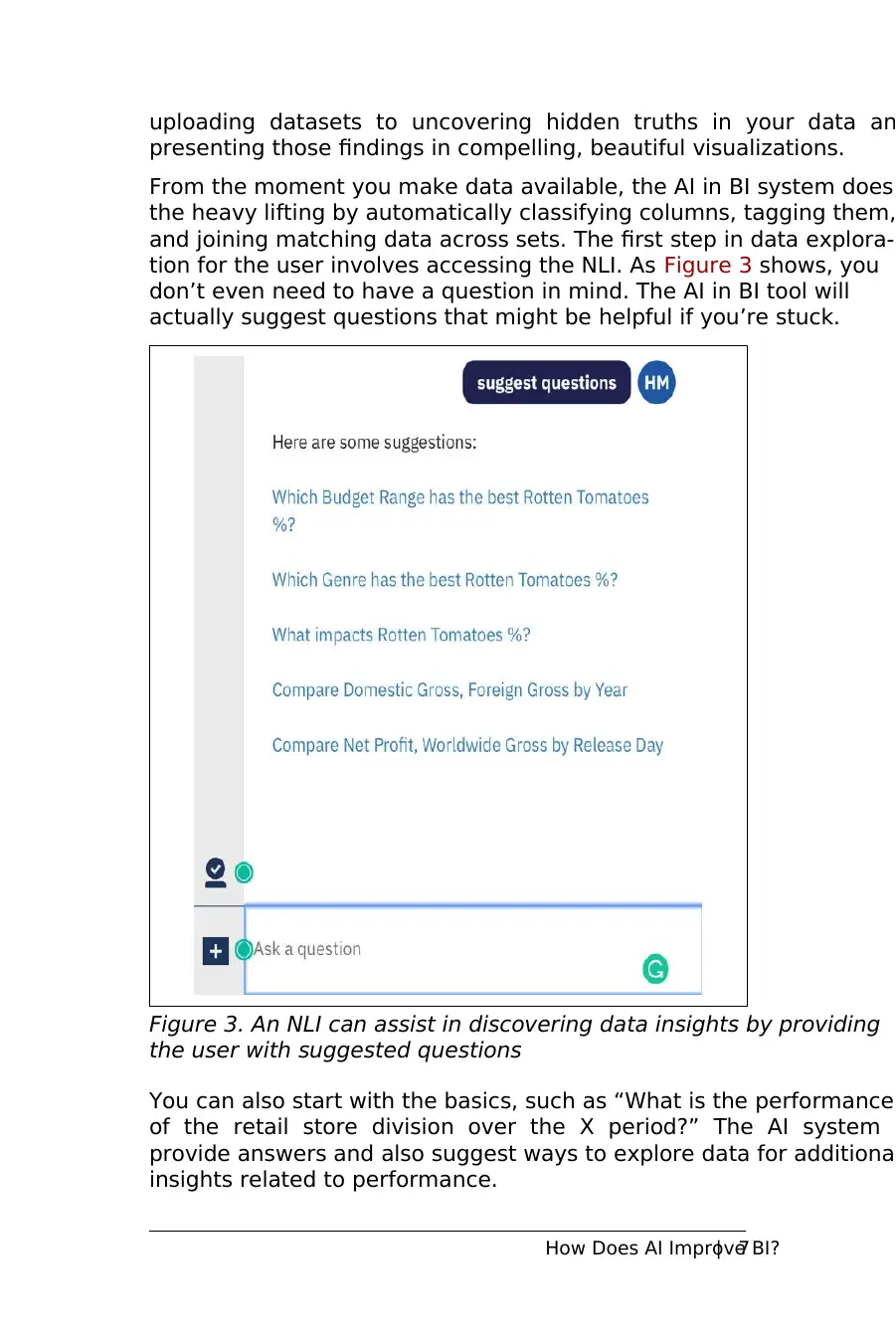
uploading datasets to uncovering hidden truths in your data an
presenting those findings in compelling, beautiful visualizations.
From the moment you make data available, the AI in BI system does
the heavy lifting by automatically classifying columns, tagging them,
and joining matching data across sets. The first step in data explora‐
tion for the user involves accessing the NLI. As Figure 3 shows, you
don’t even need to have a question in mind. The AI in BI tool will
actually suggest questions that might be helpful if you’re stuck.
Figure 3. An NLI can assist in discovering data insights by providing
the user with suggested questions
You can also start with the basics, such as “What is the performance
of the retail store division over the X period?” The AI system w
provide answers and also suggest ways to explore data for additional
insights related to performance.
How Does AI Improve BI?| 7
presenting those findings in compelling, beautiful visualizations.
From the moment you make data available, the AI in BI system does
the heavy lifting by automatically classifying columns, tagging them,
and joining matching data across sets. The first step in data explora‐
tion for the user involves accessing the NLI. As Figure 3 shows, you
don’t even need to have a question in mind. The AI in BI tool will
actually suggest questions that might be helpful if you’re stuck.
Figure 3. An NLI can assist in discovering data insights by providing
the user with suggested questions
You can also start with the basics, such as “What is the performance
of the retail store division over the X period?” The AI system w
provide answers and also suggest ways to explore data for additional
insights related to performance.
How Does AI Improve BI?| 7
⊘ This is a preview!⊘
Do you want full access?
Subscribe today to unlock all pages.

Trusted by 1+ million students worldwide
1 out of 25
Your All-in-One AI-Powered Toolkit for Academic Success.
+13062052269
info@desklib.com
Available 24*7 on WhatsApp / Email
![[object Object]](/_next/static/media/star-bottom.7253800d.svg)
Unlock your academic potential
Copyright © 2020–2025 A2Z Services. All Rights Reserved. Developed and managed by ZUCOL.